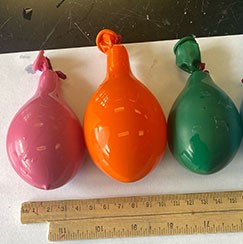
Summary
Through two lessons and their associated activities, students explore cellular respiration and population growth in yeasts. Yeast cells are readily obtained and behave predictably, so they are very suitable for use in middle school classrooms. Students are presented with information that enables them to recognize that yeasts are unicellular organisms that are useful to humans.Engineering Connection
Lessons and activities in this unit contain biomedical and chemical engineering topics such as biotechnology, applications of experimental and analytical techniques in living systems, food processing and processes of nature. Students also learn about the procedure used by engineers and scientists when designing experiments with controls.
Unit Overview
In the first lesson, What Do Bread and Beer Have in Common?, students are introduced to yeast respiration through its role in the production of bread and alcoholic beverages. A discussion of the effects of alcohol on the human body is used both as an attention-getting device, and as a means to convey important information at an impressionable age. In the associated activity, Yeast Cells Respire, Too (But Not Like Me and You), students set up a simple way to indirectly observe and quantify the amount of respiration occurring in yeast-molasses cultures.
Based on questions that arise from the first activity, in the second lesson, Population Growth in Yeasts, students work in small groups as they design and execute their own experiments to determine how environmental factors affect yeast population growth. In the associated activity, How to Make Yeast Cells Thrive, students set up and run the experiments they designed using simple yeast-molasses cultures in test tubes. They test for a variety of environmental influences, such as temperature, food supply and pH.
Educational Standards
Each TeachEngineering lesson or activity is correlated to one or more K-12 science,
technology, engineering or math (STEM) educational standards.
All 100,000+ K-12 STEM standards covered in TeachEngineering are collected, maintained and packaged by the Achievement Standards Network (ASN),
a project of D2L (www.achievementstandards.org).
In the ASN, standards are hierarchically structured: first by source; e.g., by state; within source by type; e.g., science or mathematics;
within type by subtype, then by grade, etc.
Each TeachEngineering lesson or activity is correlated to one or more K-12 science, technology, engineering or math (STEM) educational standards.
All 100,000+ K-12 STEM standards covered in TeachEngineering are collected, maintained and packaged by the Achievement Standards Network (ASN), a project of D2L (www.achievementstandards.org).
In the ASN, standards are hierarchically structured: first by source; e.g., by state; within source by type; e.g., science or mathematics; within type by subtype, then by grade, etc.
See individual lessons and activities for standards alignment.
Subscribe
Get the inside scoop on all things TeachEngineering such as new site features, curriculum updates, video releases, and more by signing up for our newsletter!Unit Schedule
- Day 1: What Do Bread and Beer Have in Common? lesson
- Day 2 and Day 6: Yeast Cells Respire, Too (But Not Like Me and You) activity (Note: 40-minute setup; ~5 minutes/day for observations for 3-4 days; 30 minutes for discussion and graphing results)
- Day 3: Population Growth in Yeasts lesson
- Day 4 and Day 8: How to Make Yeast Cells Thrive activity (Note: 30-minute setup; ~3 minutes/day for observations for 3-4 days; 30 minutes for discussion and graphing results)
More Curriculum Like This

Students learn that yeasts, a type of fungi, are unicellular organisms that are useful to humans.

Based on questions that arose during the first lesson and its associated activity, students in this lesson work in small groups to design experiments that determine how environmental factors affect yeast population growth.

Students set up a simple way to indirectly observe and quantify the amount of respiration occurring in yeast-molasses cultures. Each student adds a small amount of baking yeast to a test tube filled with diluted molasses.

Students conduct a research-based activity to explore, graph, and analyze data, and evaluate the efficiency of alcoholic fermentation via reactant type and reactant concentration. They design and observe experiments in a closed system (a balloon), and measure CO2 production (CO2 Volume) through wate...
Assessment
For end-of-unit assessment, use any of the questions provided in the Assessment sections of the lessons and associated activities in this unit. To avoid repeating verbatim the assessments in Population Growth in Yeasts (lesson 2) and How to Make Yeasts Thrive (associated activity for lesson 2), or the assessment for the Yeast Cells Respire, Too activity, slightly alter the scenarios presented, while keeping the student questions the same.
Copyright
© 2013 by Regents of the University of Colorado; original © 2004 Duke UniversityContributors
Mary R. Hebrank, project and lesson/activity consultantSupporting Program
Engineering K-PhD Program, Pratt School of Engineering, Duke UniversityAcknowledgements
This content was developed by the MUSIC (Math Understanding through Science Integrated with Curriculum) Program in the Pratt School of Engineering at Duke University under National Science Foundation GK-12 grant no. DGE 0338262. However, these contents do not necessarily represent the policies of the NSF, and you should not assume endorsement by the federal government.
Last modified: August 23, 2017







User Comments & Tips